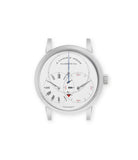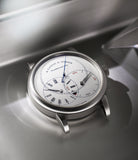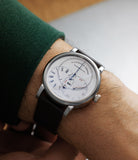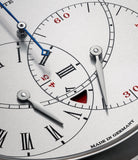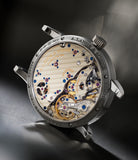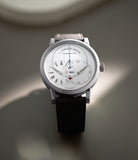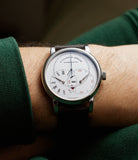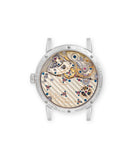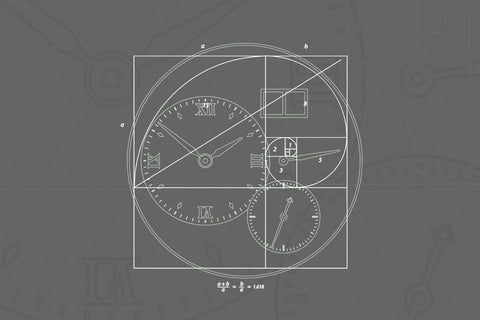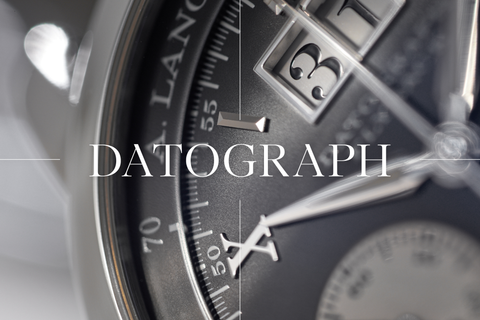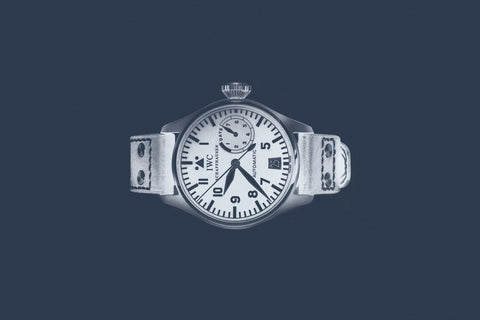Almost 12 years after Walter Lange and Günter Blümlein resurrected A. Lange & Söhne in 1994, the brand first introduced the Richard Lange family of watches. The line, focussed on precision, purpose-led timekeeping, is perhaps best characterised by its observation watches made for scientific expeditions and navigation. The line champions classic complications aimed at functional chronometry.
The Richard Lange Jumping Seconds incorporates a deadbeat seconds function. The original deadbeat escapement was devised in 1675 by Richard Towneley for use in regulator clocks at Greenwich Observatory, due to its useful and precise seconds indication.
In this watch, this trait is thanks to the one-second remontoir d'egalité system, whose primarily purpose is to provide constant force to the escapement, producing linear chronometric performance. The remontoire's function also advances the seconds hand in clear one-second increments. The movement also incorporates a zero-reset mechanism – pulling out the crown to set the time sends the hand in the central seconds register to the zero position. This ‘mini complication’ is achieved through a heart-shaped cam, the set up similar to the reset mechanism in chronographs.
This particular watch is one of a limited series of 100 with a case made of platinum measuring just under 40mm across. The three-part case features brushed and rounded bezel, satinated midcase and a display caseback rim with a polished wall. The lugs, stepped from the case, are high polished too. The watch comes on an alligator-grained leather strap with a signed platinum buckle.
The dial was inspired by the regulator-style layout of a piece by 18th century watchmaker Johann Heinrich Seyffert. In the Richard Lange Jumping Seconds, this has been interpreted as an overlapping triple register format. The largest and central one, framed by a chemin de fer track, indicates the deadbeat seconds. The one to the bottom right indicated the minutes, with a quarter chapter of ruby red, Arabic indices. The register to the bottom left of the dial features a full black 12-hour chapter of Roman numerals to indicate the hour of the day. In between the hours and minutes registers, incorporated in a very visually satisfying way, is a triangular power reserve indicator that goes ruby red when the mainspring has about 10 hours of reserve left. Subtle differences in colour and style of numerals serve to distinguish the registers and aid quick readability. While the hours and minutes are indicator by lancet-style hands, the seconds hand is a simple pointer that has been heat-blued.
The manually wound calibre L094.1 offers 42 hours of reserve and the balance beats at 21,600 vibrations per hour. Dominating almost half of the movement side is a bridge crafted from the brand’s signature German silver. It is richly decorated with striping while the visible jewels are ensconced in gold chaton. A wheel-shaped aperture reveals one of the two underlying drive trains. The balance bridge is free-hand engraved, another key visual detail of A. Lange & Söhne.
The Richard Lange Jumping Seconds in platinum is a rare and exceedingly precious interpretation of one of the more interesting takes on a regulator-style layout, underpinned by a technically advanced calibre and a natural deadbeat seconds complication. It is especially attractive to enthusiasts who seek more unusual examples of the German maker’s offering.































































































































































































